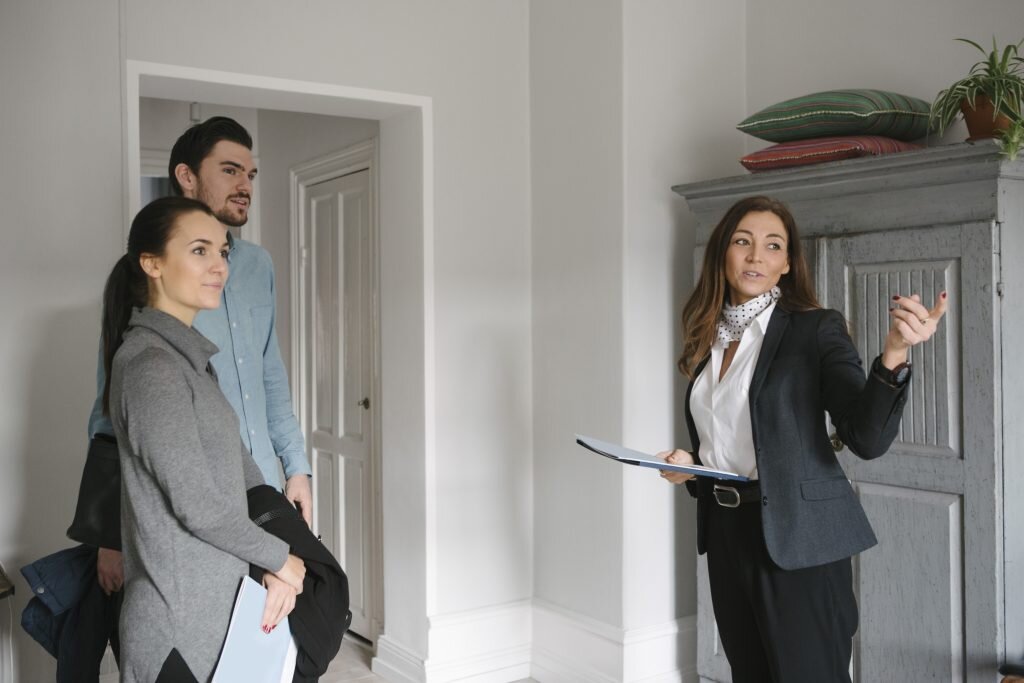Real estate showings give potential buyers the opportunity to see and experience your home in person. Showings are a very important part of the home buying and selling process — in fact, according to the Zillow Group Consumer Housing Trends Report 2018, 79% of buyers said that taking a private tour was extremely or very important to their home-buying decision.
What is a real estate showing?
A real estate showing is any opportunity you give a potential buyer to see your home in person. It could be an open house, a lockbox tour or a private showing.
If you’re looking for a conventional buyer, and if you want to encourage multiple offers, avoiding showings isn’t really an option. Sight-unseen sales are extremely rare, unless you’re dealing with international or out-of-town buyers.
Whether you’re looking forward to showing off your home to potential buyers or dreading the process, here’s how to show a home for sale.
What is an open house?
In an open-house format, all potential buyers come at once, usually over the course of a three- to four-hour period on a weekend afternoon. A well-attended open house can help you streamline the showing process, since more people can see your home at once. It can also spark a competitive spirit in potential buyers, as they may want to rush to get their offer in before anyone else.
Open houses can minimize the inconvenience of showings — you’ll only have to get your house buyer-ready one time, and you’ll know the schedule ahead of time. Open houses can also help you capture potential buyers who might just be out exploring the neighborhood.
A downside to open houses — not everyone who attends your open house is an interested or qualified buyer. Open houses attract a lot of lookie-loos who might not actually want to buy your house.
What is a lockbox house showing?
More convenient than private tours, lockbox tours allow potential buyers to look at your home with their own agent. Since they can access your home with a lockbox, this setup allows more flexibility in scheduling. They can let themselves in rather than waiting for your agent to show the house.
Buyers often like lockbox tours because they’re able to speak freely about their opinions on the house without worrying about the seller’s agent listening.
One downside to consider is potential security issues that come with letting strangers into your home while you’re not there — more on safety precautions later.
What is a private house showing?
Perhaps the most common home tour arrangement, a private house showing is when your agent gives buyers a personal tour of the home. Sometimes, serious buyers request a private tour of the home after attending an open house — this is a good sign!
A private tour allows sellers and their agents to control the showing. The agent can answer all of the buyer’s questions in real time, point out your home’s best features, and make sure nothing gets damaged or stolen.
One downside to private tours is that since you or your agent will be on-site, buyers may feel uncomfortable getting a true feel for the home, which might include opening closets, spending time in every room, checking out storage spaces, and talking through their likes and dislikes.
Preparing to show a house for sale
House showings can be scheduled without much advance notice, so ideally, your home should be kept spotless while it’s listed for sale. You want to be prepared to show the house whenever someone calls.
If you have an open house scheduled, you have the benefit of knowing how much prep time you have. But with lockbox or private tours, you may have only between a half an hour and a few hours’ notice. Here are some tips for preparing your home for showings.
Before the first showings
- Clean thoroughly: Steam the carpets, mop or vacuum hard floors, clean windows, polish appliances and give the bathrooms a serious scrubbing.
- Secure your belongings: Lock away any valuables to avoid theft of expensive items or private information.
- Have a plan for pets and kids: Your showings are much more likely to go smoothly if family pets or young family members aren’t around.
- Depersonalize and declutter: Room by room, remove little items that clutter up the space and make rooms look smaller. Remove family photos and personalized decor — you want buyers to picture themselves living in the home, and they can’t do that with your family pictures on the wall.
- Rearrange furniture as needed: Remove furniture to make rooms seem bigger, and swap pieces in and out of different rooms to give each space an obvious purpose. For example, add a desk and chair to a bonus room to show it as a home office, or move a twin bed into an empty bedroom.
- Don’t forget the outside: Curb appeal helps your home make its first impression, and your to-do list will vary seasonally. Common tasks include planting flowers, pulling weeds, mowing the lawn, raking and shoveling snow.
- Keep storage spaces tidy: Every buyer is looking for a home with plenty of storage, which means they’re going to be opening your closets, pantry and garage doors. Don’t just shove extra belongings into closets — they need to look tidy and not overfilled.
- Highlight the best features: Identify the features that are most attractive about your home. If you have beautiful hardwood floors, remove the rug that’s covering them up. Love your stainless steel appliances? Don’t hide them behind refrigerator magnets or dish towels.
Ongoing home showing tips
- Keep family members in the loop: Make sure everyone who lives in your house knows when showings are scheduled so they can keep their spaces tidy.
- Do a daily cleaning: Be vigilant about cleaning up daily messes, like crumbs on the table, coffee spills on the counter or toothpaste drips in the bathroom.
- Avoid strong-smelling foods: Keep your meal prep simple and avoid foods that leave long-lasting odors.
- Keep pet areas clean: Clean up after your pets immediately and wash their bedding regularly.
- Make it light and bright: Open blinds and curtains to let in as much natural light as possible, and leave lights on when you vacate for a showing.
- Hide pet food or litter: Not everyone is a dog or cat person! Buyers shouldn’t even be able to tell you have a pet.
- Empty trash cans: To avoid bad odors, regularly empty trash cans in every room.
- Set the thermostat to a comfortable temperature: If tours will be happening when you’re at work and you usually turn the heat off, keep it on so that buyers will be comfortable during their tour. Same goes for the summer — if you have a nice, cool house, buyers will be inclined to stay longer and enjoy the home.
- Provide refreshments: Make your home feel welcoming with snacks, candy and desserts. Don’t forget to leave a garbage can in plain sight so visitors can clean up after themselves.
- Consider seasonal ambience: A fall fire in the fireplace, winter hot chocolate or freshly cut spring flowers are always nice touches.
- Ask the neighbors for help: If you’re on good terms with your neighbors, you can ask for their cooperation in keeping their dogs from barking.
Tips for real estate photo editing
If you have the know-how (and the subscription!) Photoshop is a great tool for editing your real estate photos. But, even if you’re not Photoshop-savvy, there are a few online tools that make editing photos a breeze, like Photoshop Express, Pixlr, or GIMP. Use them to make a few simple enhancements.
- Use HDR: HDR is a method of shooting multiple images at once, then combining them in editing for better lighting and corrected vertical lines (more on that later).
- Swap a gray sky for a blue sky: Did your exterior shots on a cloudy day? No problem. You can easily swap the sky for blue.
- General editing: Crop, brighten, and fix blemishes to make your home look its best.
Include these shots: Photographing real estate 101
Consider this your listing photography checklist, and don’t stop shooting until you have a great real estate photo for each of these spaces.
Must-have photographs
Master bedroom
Kitchen
Living room
Bathrooms
Nice-to-have photographs
Patio or deck
Landscaping
Pool or hot tub
Shop
Outbuildings
Real estate shots that sell
Popular local features: If you’re working with an agent, ask for their opinion on which features to highlight for your own local market (according to an analysis of listing keywords, you’ll find mudrooms in Vermont, southern exposure in Alaska, and storm cellars in Oklahoma).
Features that justify higher prices: Certain home features highlighted on Zillow have helped sellers earn more than their asking prices or shorten the length of time homes sit on the market. A few examples include steam showers, professional appliances, and solar panels.
Views: Highlight any notable views from the home. Water, mountain, or cityscape vistas from windows are always popular.
Architectural details: If your home is of a particular style, showcase its notable details, such as wainscoting, exposed beams, or intricate tile work.
Recently updated spaces: If you’ve recently done renovation work on the home, show it off!
Bonus shots
An exterior shot from the curb, showing off the curb appeal
An exterior shot at night, with lights glowing from the interior
A dusk shot on a clear night
An exterior shot with the front door open, for a welcoming scene
Drone footage or aerial views
3D Home tours and video walkthroughs — adding a video walkthrough can double both the number of shopping views and frequency that the home is saved on Zillow
Avoid real estate photography mistakes
Now that we’ve talked about what to do for great real estate photos, let’s cover the pitfalls you should avoid.
Common real estate photography errors
- The photographer’s reflection in a mirror or window
- Pets in the shot
- Ceiling fans running
- Television on
- Fingerprints on surfaces
- Raised toilet seat lids
- Cars or other distractions captured through windows
- Unsightly items in exterior shots, like electrical wires, dumpsters, or parked cars
- Including images of tiny rooms — leave out closets, laundry rooms, and powder rooms unless they have a unique selling point
- Including images of structural issues or unfinished rooms — if it’s mid-remodel, don’t include it in the photos
- Vertical line distortion — this common mistake happens when you shoot images with your camera tilted up or down, making vertical lines bow in or diverge, and should be fixed in post-shoot editing
- Using a cell phone to take pictures
- Using a fish-eye lens, which can portray an unrealistic sense of size
What equipment is needed to become a real estate photographer?
Whether you’re just taking photos of your own house to sell it, or if you’re interested in dabbling in the field of professional real estate photography, here is the equipment you need to produce high-quality, high-resolution real estate images.
- A professional camera: You’ll need a full frame digital SLR camera, with a large sensor for a wider field of view and highest quality.
- A wide-angle lens: A wide-angle lens lets you capture more of each room, with full detail and depth.
- A tilt-shift lens: A professional tilt-shift lens can help you avoid the vertical line distortion that’s an easy giveaway that photos were done by an amateur.
- A tripod: When your camera is secured on a tripod, you can capture crisp images with a slower shutter speed, which allows for more natural light.
- More than one flash: You’ll want to be equipped with supplemental lighting for larger rooms.
- Light stand: A professional light stand allows you to light a room effectively.






